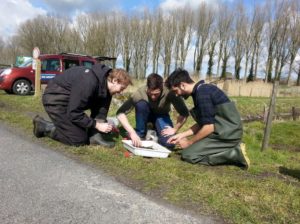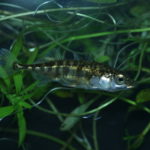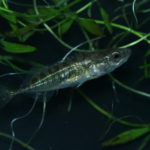Evolutionary ecology of coexisting stickleback species
Part of the capacity of a species to respond to  environmental change depends on its evolutionary potential, which is rooted in the amount and structure of adaptive genetic variation. We previously showed that two coexisting and closely related fishes – three-spined and nine-spined stickleback – differ markedly in the strength and nature of local adaptation between brackish water and freshwater populations. This indicates that both species cope with landscape-level ecological heterogeneity in fundamentally different ways. We aim to improve our overall understanding of how adaptation is achieved in both species at the genetic, regulatory and epigenetic level.
environmental change depends on its evolutionary potential, which is rooted in the amount and structure of adaptive genetic variation. We previously showed that two coexisting and closely related fishes – three-spined and nine-spined stickleback – differ markedly in the strength and nature of local adaptation between brackish water and freshwater populations. This indicates that both species cope with landscape-level ecological heterogeneity in fundamentally different ways. We aim to improve our overall understanding of how adaptation is achieved in both species at the genetic, regulatory and epigenetic level.
Three-spined stickleback as a ecotoxicological sentinel species for mercury pollution
Although many aquatic species are negatively affected by environmental pollution, some populations of fishes seem to thrive in heavily polluted environments. Three-spined sticklebacks are fairly robust and opportunistic fish that occur in both pristine and heavily polluted aquatic environments. Studying the tolerance and adaptation of these fish to their contaminated environments may provide us with valuable insights for environmental risk assessment. We previously showed that muscle mercury accumulation levels at sites with differing levels of pollution are associated with genome-wide differences in three-spined stickleback populations in Flanders (Belgium). This suggests that there might be a genetic basis for adaptation to mercury pollution in these fish. We are now investigating potential transcriptional and gut microbial responses to mercury pollution. In the future, we are also aiming to expand our research to include populations across the latitudinal range of the species to better describe responses to pollution under multiple climatic regimes.
Fish genetic connectivity and adaptation due to human-mediated hydraulic effects
Human intervention in natural fluvial systems through the construction of hydraulic structures such as weirs and dams has led to problems in aquatic biodiversity. In addition to minimizing gene flow between populations, these engineering structures can also alter the flow regime and disrupt biogeochemical transportation from upstream to downstream. Compared with the fast evolution of some fish, which can occur in just a few generations, hydraulic structures can have long-lasting impacts on riverine fish for decades or even centuries. Therefore, understanding how hydraulic structures act as selective factors on biota and systematically evaluating their impact on the fluvial system is necessary for biodiversity conservation. The three-spined sticklebacks are resistant to pollutants, have high abundance, no stock policy, and a high-quality reference genome, making them an excellent model organism for studying the effects of hydraulic structures on riverine fish. This international collaborative research project involves researchers from hydraulic engineering and evolutionary biology at the University of Ottawa (Canada), McGill University (Canada), Nord University (Norway), KU Leuven (Belgium), and the University of Connecticut (USA).
Collaborators:

Thijs Mattheus Peter Bal
Aruna M Shankregowda
Kostas Sagonas
Brijesh Yadav
Joost Raeymaekers
Filip Volckaert
Io Deflem
Federico Calboli
Vyshal Delahaut
Fabien Lamaze
Gudrun De Boeck
Christophe Eizaguirre
Doko Miles Jackson Thorburn
Pascal Hablützel
Anurag Chaturvedi
Xiatong Cai
Marijn Kuizenga